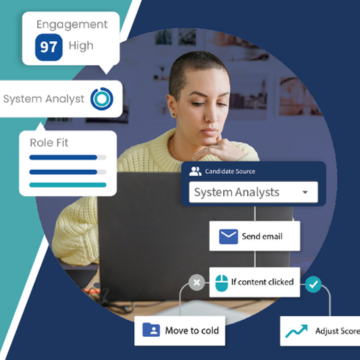- Solutions
- Products
- Community
- Resources
- Company
Create incredible candidate experiences that communicate your brand, mission, and values with recruitment marketing solutions.
Learn moreCommunicate effectively and efficiently with the candidates that can drive your business forward.
Learn moreSelect the right candidates to drive your business forward and simplify how you build winning, diverse teams.
Learn moreHelp your best internal talent connect to better opportunities and see new potential across your entire organization.
Learn moreCommunicate collectively with large groups of candidates and effectively tackle surges in hiring capacity.
Learn moreAccess tools that help your team create a more inclusive culture and propel your DEI program forward.
Learn moreRebound and respond to the new normal of retail with hiring systems that are agile enough to help you forge ahead.
Learn moreAccelerate the hiring of key talent to deliver point of care and support services that meet and exceed your promise of patient satisfaction.
Learn moreAttract and engage candidates with technical competencies, accelerate hiring for much-needed skills, and advance expertise within your valued workforce.
Learn moreSimplify how you recruit finance, insurance, and banking candidates with a unified platform built to match top talent with hard-to-fill roles.
Learn moreYour business strategy depends on your people strategy. Keep both in lockstep with the iCIMS Talent Cloud.
Learn moreBuild an engaging, high-converting talent pipeline that moves your business forward.
Learn moreDeliver the innovation your talent team needs, along with the global scale and security you demand.
Learn moreDeliver tailored technology experiences that delight users and power your talent transformation with the iCIMS Talent Cloud.
Learn moreThe #1 ATS in market share, our cloud-based recruiting software is built for both commercial and large, global employers.
Learn more Talk to salesAttract the best talent for your business with powerful, on-brand career websites that excite candidates and drive engagement.
Learn more Talk to salesCombine behavior-based marketing automation with AI insights to build talent pipelines, engage candidates with multi-channel marketing campaigns, and automatically surface the right talent for the job.
Learn more Talk to salesEmpower candidates with automated self-service, qualification screening, and interview scheduling through an AI-enabled digital assistant.
Learn more Talk to salesSimplify employee onboarding with automated processes that maximize engagement and accelerate productivity.
Learn more Talk to salesCompliment your sourcing and engagement efforts with award-winning lead scoring and advanced campaign personalization.
Learn more Talk to salesImprove employee experience, retention, and reduce internal talent mobility friction with the iCIMS Opportunity Marketplace.
Learn more Talk to salesVerify skills with game-changing levels of automation and simplicity to improve the quality of hire at scale.
Learn more Talk to salesModernize, streamline, and accelerate your communication with candidates and employees.
Learn more Talk to salesTransform the talent experience by showcasing your authentic employer brand through employee-generated video testimonials.
Learn more Talk to salesSimplify recruiting, dynamically engage talent, and reduce hiring bias with job matching and recruiting chatbot technology.
Learn more Talk to salesGet exclusive intel on industry and market trends along with expert one-on-one advice.
Learn more Talk to salesThe #1 ATS in market share, our cloud-based recruiting software is built for both commercial and large, global employers.
Learn more Talk to salesAttract the best talent for your business with powerful, on-brand career websites that excite candidates and drive engagement.
Learn more Talk to salesCombine behavior-based marketing automation with AI insights to build talent pipelines, engage candidates with multi-channel marketing campaigns, and automatically surface the right talent for the job.
Learn more Talk to salesEmpower candidates with automated self-service, qualification screening, and interview scheduling through an AI-enabled digital assistant.
Learn more Talk to salesSimplify employee onboarding with automated processes that maximize engagement and accelerate productivity.
Learn more Talk to salesCompliment your sourcing and engagement efforts with award-winning lead scoring and advanced campaign personalization.
Learn more Talk to salesImprove employee experience, retention, and reduce internal talent mobility friction with the iCIMS Opportunity Marketplace.
Learn more Talk to salesVerify skills with game-changing levels of automation and simplicity to improve the quality of hire at scale.
Learn more Talk to salesModernize, streamline, and accelerate your communication with candidates and employees.
Learn more Talk to salesTransform the talent experience by showcasing your authentic employer brand through employee-generated video testimonials.
Learn more Talk to salesSimplify recruiting, dynamically engage talent, and reduce hiring bias with job matching and recruiting chatbot technology.
Learn more Talk to salesGet exclusive intel on industry and market trends along with expert one-on-one advice.
Learn more Talk to salesHow a beloved restaurant hires 40,000+ annually with a great candidate experience.
Learn moreThousands strong, our global community of talent professionals includes creatives, innovators, visionaries, and experts.
Learn moreTogether we’re creating the world’s largest ecosystem of integrated recruiting technologies.
Learn morePartner with our global professional services team to develop a winning strategy, build your team and manage change.
Learn moreExplore our network of more than 300 certified, trusted third-party service and advisory partners.
Learn moreUncover unique market insights, explore best practices and gain access to talent experts across out library of content.
Get resourcesExpert guidance about recruitment solutions, changes in the industry, and the future of talent.
Learn moreStay up to date with the latest terminology and verbiage in the HR software ecosystem.
Learn moreEmployers everywhere improve hiring efficiently and save money using iCIMS. Estimate the potential business value you can achieve.
Learn moreDive into the Class of 2023 Report highlighting this cohort’s expectations and where employers are willing — and able — to meet them.
Watch nowPartner with iCIMS to build the right strategies, processes, and experience to build a winning workforce.
Learn moreExpert guidance about recruitment solutions, changes in the industry, and the future of talent.
Learn moreThe iCIMS Talent Cloud delivers a secure, agile, and compliant platform designed to empower talent teams, job seekers, and partners with advanced data protection and privacy.
Learn moreView press releases, media coverage, and the latest hiring data. See what analysts are saying about iCIMS.
Learn moreiCIMS is the Talent Cloud company that empowers organizations to attract, engage, hire, and advance the talent that builds a winning workforce.
Learn moreGet to know the award-winning leadership team shaping the future of the recruiting software industry.
Learn moreWe believe the future of work isn't something that "happens" to you. It's something you create. We actively create the future of work with our customers every day.
Learn moreiCIMS is committed to being a responsible and ethical corporate citizen, which is why Environmental, Social and Governance (ESG) initiatives are strategic imperatives.
Learn moreStreamline your tech stack and take advantage of a better user experience and stronger data governance with ADP and the iCIMS Talent Cloud.
Learn moreThe combined power of iCIMS and Infor helps organizations strategically align their business and talent objectives.
Learn moreOur award-winning partnership with Microsoft is grounded in a shared desire to transform the workplace and the hiring team experience.
Learn moreOur partnership with Ultimate Kronos Group (UKG) supports the entire talent lifecycle by bringing frictionless recruiting solutions to UKG Pro Onboarding.
Learn moreLet’s get in touch. Reach out to learn more about iCIMS products and services.
Learn more

What does it take to get the C-suite on board with an investment in new HR software? No doubt, the CEO, CIO, and CFO all favor technologies that increase productivity and reduce costs. However, they must also consider competing priorities, critical business challenges, budgets, the available bandwidth for an implementation, employee sentiment, and how much improvement a new software provides.
As an HR professional, you need to sort through the features and benefits of new technology to identify what your C-suite really cares about.
Here are some tips to secure buy-in from key decision makers across the C-suite to help you get the technology you need.
Before you can get buy-in, identify who will act as a decision maker in the purchasing process. For HR software, this is commonly the CEO, CIO, and CFO or someone from their office acting on their behalf. These decision makers will make up your buying committee – the people who will give the green light for your request. So, how do you get them on board?
First, ask them to get involved. They don’t have to commit to the project up front, but if you can get their feedback early in the process, they may feel more invested in its success.
Second, think long term. Selling tech internally doesn’t happen overnight. It’s usually a significant investment of resources, and C-suite leaders need time to measure the risks and rewards.
Third, although you may be excited about sharing the specifics of the software, the C-suite doesn’t need to know every detail. They do need to understand how this software can help the organization make money, avoid risk, or provide a long-term strategic or competitive advantage.
Once you’ve identified your buying committee, the next step is to understand what matters to them– the what’s in it for me (WIIFM). Salespeople know that customers may not care about all of a product’s features. Instead, customers want to see how the product benefits them – how it solves their specific needs.
This same approach can help you pitch technology to the C-suite. Find out what each decision-maker cares about to craft your discussion on how this software can address their pain points.
Let’s look at what’s top of mind for most C-level executives:
What keeps your chief executive officer up at night? The exact answer will be specific to your organization’s circumstances, but most leaders have similar concerns.
According to The Conference Board (a global, nonprofit research group) U.S. CEOs listed labor shortages as their top external challenge in 2022. In the iCIMS 2022 Workforce Report, 92% of C-level business leaders said their organization wouldn’t be able to meet goals without the right talent.
To attract candidates with the skills needed to support business objectives, CEOs may want to create a candidate experience that makes it as easy to apply to a job as it is to buy from Amazon.
When you speed up the recruiting process, you can hire the right talent faster and lose fewer candidates due to a slow tracking and hiring system.
Additionally, CEOs can use the same philosophy to improve retention by giving employees a self-service marketplace to track their skills, match with open roles, and develop their career path.
What kind of technology helps? Candidate relationship management software helps your company find potential employees and helps those potential employees locate you. The bigger the applicant pool, the more likely you’ll find the right skills match. Data analytics and applicant tracking systems (ATS) also help recruiters identify skill and talent gaps to get the right person on board faster.
For talent retention, an internal talent marketplace can improve mobility so that the talent you’ve worked so hard to attract stays and remains engaged and productive.
The chief information officer manages information technology and strategy throughout the company. CIOs don’t have to be sold on the benefits of technology – they’re already all in. A recent CIO.com article states that the biggest concerns for chief information officers this year are improving cybersecurity skills, enhancing digital dexterity within the IT department, advancing automation, and updating talent recruitment throughout the company.
CIOs need to ensure that any new HR technology is a worthwhile investment by making employees’ lives easier, not more difficult. Also, since many companies use a variety of platforms depending on department or function, CIOs wants to make sure all of them work together. Ultimately, CIOs want to make sure any new HR technology is a smart investment for the business as a whole.
The CIO can become your best advisor or ally. As you consider software solutions, involve the CIO early as they may have advice for evaluating tech vendors or requirements for any new technology. They may need to become partners for managing or maintaining the technology once it’s implemented, so getting them on board early is a bonus.
CIOs look for technology that offers secure, agile, and compliant platforms. They understand that the future is uncertain and want technology that can grow with evolving needs. Cloud-based software can reduce the need for internal infrastructure, which can save money by requiring less tech and fewer on-site staff to maintain the infrastructure.
As the person responsible for protecting the company’s vital assets, the chief financial officer is willing to spend money when they feel confident that the investment will pay off – and when that is likely to happen.
To interest your CFO in investing in new HR technology, help them understand the overall commitment. Outline the total cost of ownership and compare the recommended technology with the competition in terms of costs for licensing, customization and integration, data migration, maintenance, and staff training. Be prepared to detail the return on investment with quantitative and qualitative results.
Explain to your CFO how the organization can save money by consolidating existing costly technologies or how it can improve ROI through more efficient recruiting practices. Look at how the technology removes hidden costs, bottlenecks, and duplicate work. Whenever possible, break down these benefits into metrics that tie into the bottom line. For example, if a technology reduces a work process by 50 percent, consider how many people do the work process, how often, and how much time and salary are spent on it to develop a reasonable cost savings estimate.
Once you collect all the information on what matters most to your buying committee and know what technology you want to recommend, align your messaging to show how the technology addresses your C-suite’s pain points.
As you do, draw on your shared goals of creating organizational success by improving agility, accuracy, efficiency, and engagement, and bring details of how the new technology can help achieve this goal. Be specific about how you’ll measure the technology’s short- and long-term improvements.
In the last few years, leaders in every function have developed a renewed appreciation for employees. Along with that, organizations have increasingly looked to you to provide consultation and direction. Because of that you are in an ideal position to recommend investments in HR technology that can help move your organization forward.




